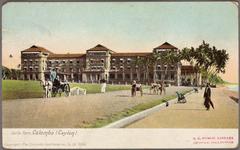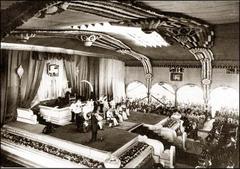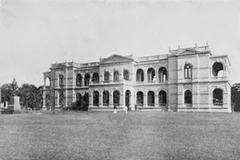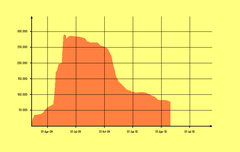Wolvendaal Church: Visiting Hours, Tickets, and Historical Significance in Colombo District, Sri Lanka
Date: 04/07/2025
Introduction
Wolvendaal Church is one of Colombo’s most enduring colonial monuments, exemplifying the city’s rich Dutch heritage and religious history. Built on the prominent Wolvendaal Hill, its imposing Doric architecture, storied past, and ongoing role as a place of worship make it a must-visit for history enthusiasts, architecture lovers, and travelers exploring Sri Lanka’s capital. This guide offers detailed information on visiting hours, ticketing (including free entry), guided tours, accessibility, preservation efforts, and practical tips to enhance your visit. Whether you are seeking architectural marvels, historical depth, or a peaceful cultural experience, Wolvendaal Church offers a unique window into Colombo’s colonial past and living present.
Early History of the Wolvendaal Site
Long before the church’s construction, Wolvendaal Hill—historically known as Boralugoda—played a key role in Colombo’s military and political landscape. In the late 16th century, it served as a strategic base for the Sitawaka kingdom during their siege of Portuguese-controlled Colombo, under King Mayadunne and Prince Tikiri (later King Rajasinghe I). The area’s commanding elevation made it a natural choice for fortifications and, later, for the Dutch colonial church (Amazing Lanka).
Dutch Colonial Era and Church Foundation
With the Dutch East India Company’s takeover of Colombo in the 17th century, Wolvendaal Hill was selected for a major Protestant church, asserting Dutch influence and serving the growing Dutch Reformed community. The foundation stone was laid in 1749 under Governor Julius Valentyn Stein van Gollenesse; the church was consecrated in 1757 after eight years of meticulous construction (Sri Lanka Travel Places). It soon became the principal place of worship for the Dutch in Ceylon.
Architectural Features and Symbolism
Wolvendaal Church stands as a superb example of Dutch colonial architecture—featuring a Greek cross plan, thick kabok and coral stone walls, whitewashed exteriors, and high, gabled roofs. Its robust Doric style was not only aesthetically striking but also adapted to withstand Sri Lanka’s tropical climate (Sri Lanka Travel Places). The interior is distinguished by original hardwood pews, a 17th-century pulpit, intricate woodwork, and historical gravestones embedded in the floor—many transferred from earlier Portuguese churches. Notably, the church houses Sri Lanka’s oldest pipe organ and a belfry with a historic bell from Kotte.
Role During Colonial Transitions
Wolvendaal Church was central to Colombo’s colonial shifts. It remained the heart of the Dutch community until the British takeover in 1796, when British forces occupied Wolvendaal Hill and the Dutch capitulated without resistance (Amazing Lanka). The church continued as a religious and social hub under British rule, with additional burials and memorials marking its multicultural congregation.
Notable Burials and Memorials
The church is the final resting place for five Dutch governors, including Johan Gerard van Angelbeek, and numerous colonial-era families from Dutch, Burgher, Sinhalese, Tamil, and English backgrounds (Amazing Lanka). These gravestones and wall plaques offer a unique lens into the social fabric of colonial Colombo.
Visiting Wolvendaal Church: Practical Information
Visiting Hours and Tickets
- Opening Hours: Monday to Saturday, 9:00 AM to 5:00 PM. The church is typically closed on Sundays and major religious holidays for worship services.
- Admission: Entry is free; donations are encouraged to support ongoing preservation.
Guided Tours and Self-Exploration
- Guided Tours: Available upon request, either on arrival or by contacting the church in advance. Tours typically last 30–60 minutes and are led by knowledgeable staff or volunteers (Pelago).
- Self-Guided Visits: Informative plaques and displays provide valuable context for independent visitors.
Getting There
Located near the bustling Pettah district and Colombo Fort, Wolvendaal Church is easily accessible by taxi, tuk-tuk, or public bus. Limited parking is available nearby (Traveler Bibles).
Accessibility
Ramps and handrails are installed at main entry points, but some interior areas have uneven stone floors and may require assistance for visitors with mobility challenges.
Dress Code and Etiquette
Visitors should dress modestly (shoulders and knees covered) and remove hats inside. Silence is appreciated, especially during services or private events.
Facilities
Basic restroom facilities are available. There are no on-site cafés or shops, but the nearby Pettah district offers dining and shopping options.
Visitor Experience Highlights
- Atmosphere: Despite Colombo’s urban bustle, the church offers a tranquil, reflective environment with filtered sunlight and cool interiors.
- Photography: Permitted (without flash or tripods), but visitors should be respectful, particularly during services.
- Community: Caretakers and congregation members are often happy to share stories about the church’s history and community role.
- Events: Occasional concerts, lectures, and cultural celebrations are held, particularly during major Christian holidays.
Nearby Colonial Heritage Sites
Combine your visit with other nearby colonial landmarks, such as the Colombo Dutch Museum, Groote Kerk in Galle, Pettah Market, and Colombo Fort, for a deeper exploration of the city’s history (Sri Lanka Travel Places).
Conservation and Preservation Efforts
Wolvendaal Church is a listed heritage building, protected by Sri Lankan law and supported by the Wolvendaal Foundation and other partners. Ongoing conservation work addresses challenges posed by weather, urban development, and aging materials—using historically appropriate methods to restore masonry, woodwork, and the iconic roof (Thuppahi’s Blog). Community fundraising, government grants, and international partnerships sustain these efforts.
Community Engagement and Education
The church remains an active place of worship under the Christian Reformed Church of Sri Lanka, with services in multiple languages. Educational outreach includes guided tours for schools and heritage enthusiasts, as well as community events that celebrate Colombo’s multicultural legacy (Thuppahi’s Blog). These programs foster appreciation for the site’s unique role in Sri Lanka’s history.
Responsible Tourism and Visitor Guidelines
Visitors are encouraged to:
- Respect ongoing services and local traditions.
- Avoid touching artifacts and use photography sensitively.
- Support preservation through donations and by following established visitor guidelines.
Frequently Asked Questions (FAQ)
Q: What are Wolvendaal Church’s visiting hours?
A: Monday to Saturday, 9:00 AM to 5:00 PM. Closed on Sundays and major religious holidays.
Q: Is there an entry fee?
A: No, entry is free. Donations for maintenance are appreciated.
Q: Are guided tours available?
A: Yes, guided tours can be arranged on-site or in advance.
Q: Is the church wheelchair accessible?
A: Ramps and handrails are available, but some areas may require assistance due to uneven floors.
Q: Can I take photographs inside?
A: Yes, but without flash or tripods, and with respect for services and artifacts.
Q: How do I get there?
A: The church is in Pettah, Colombo, accessible via taxi, tuk-tuk, or public transport.
Summary and Encouragement to Explore More
Wolvendaal Church is a living monument to Sri Lanka’s colonial history, Dutch architectural excellence, and Colombo’s multicultural heritage. Its robust architecture, evocative memorials, and ongoing community engagement make it both a serene sanctuary and a vibrant cultural hub. With free access, guided tours, and proximity to other historical sites, it is an essential stop on any Colombo itinerary. Supporting the church’s preservation efforts ensures that this unique landmark remains a beacon of heritage for generations to come.
Enhance your visit by exploring nearby attractions such as the Colombo Dutch Museum, Pettah Market, and the National Museum. For self-guided tours and up-to-date information, consider using the Audiala app and following official Sri Lanka tourism platforms.
Sources and Further Reading
- Wolvendaal Church Colombo: Visiting Hours, Tickets & Historical Insights, Amazing Lanka, 2025
- Heritage and Other Importance of Colombo, Sri Lanka Travel Places, 2025
- The Wolfendhal Church in Colombo, Thuppahi’s Blog, 2018
- Wolvendaal Church Colombo Guide, Pelago, 2025
- Tourist Spots in Colombo, Traveler Bibles, 2025





